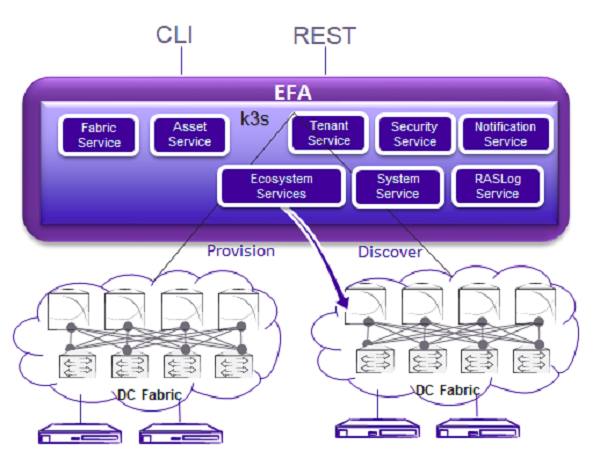EFA Microservices
EFA consists of core K3s containerized microservices that interact with each other and with other infrastructure services to provide the core functions of fabric and tenant network automation.

Fabric Service
The Fabric Service is responsible for automating the fabric BGP underlay and EVPN overlay. By default, the EVPN overlay is enabled but you can turn it off it before provisioning, if necessary. The Fabric Service exposes the CLI and REST API for automating the fabric underlay and overlay configuration.
- Support for small data centers (non-Clos)
- Support for 3-stage and 5-stage Clos fabrics
- Support for MCT configuration
Underlay automation includes interface configurations (IP numbered), BGP underlay for spine and leaf, BFD, and MCT configurations. Overlay automation includes EVPN and overlay gateway configuration.
Tenant Service
The Tenant Service manages tenants, tenant networks, and endpoints, fully leveraging the knowledge of assets and the underlying fabric. You can use the CLI and REST API for tenant network configuration on Clos and small data center fabrics.
Tenant network configuration includes VLAN, BD, VE, EVPN, VTEP, VRF, and router BGP configuration on fabric devices to provide Layer 2 extension, Layer 3 extension across the fabric, Layer 2 hand-off, and Layer 3 hand-off at the edge of the fabric.
Inventory Service
The Inventory Service acts as an inventory of all the necessary physical and logical assets of the fabric devices. All other EFA services rely on asset data for their configuration automation. The Inventory Service is a REST layer on top of device inventory details, with the capability to filter data based on certain fields. The Inventory Service securely stores the credentials of devices in encrypted form and makes those credentials available to different components such as the Fabric and Tenant services.
The Inventory Service supports the execute-cli option for pushing configuration and exec commands to devices. Examples include configuring SNMP parameters or OSPF configurations. This means you can use EFA for SLX-OS commands and push the same configuration to multiple devices.
The Asset Service provides the secure credential store and deep discovery of physical and logical assets of the managed devices. The service publishes the Asset refresh and change events to other services.
Notification Service
The Notification Service sends events, alerts, and tasks to external entities. Notifications sent from EFA are derived from the syslog events received from the devices that EFA manages. Alerts are notifications that services in EFA send for unexpected conditions. Tasks are user-driven operations or timer-based tasks such as device registration or fabric creation.
RASlog Service
The RASlog Service processes syslog messages from devices and forwards notifications to subscribers. For more information, see RASlog Service in the Extreme Fabric Automation Administration Guide, 2.7.0 .
Security Service
The Security Service consists of authentication and authorization features that enforce a security boundary between northbound clients and downstream operations between EFA and SLX devices. The service also validates users and their credentials through Role-based Access Control (RBAC) and supports local and remote (LDAP) login.

Note
If you configure LDAP server over SSL, and use IP to connect to the server, ensure that the certificate includes the IP as part of SANs for a successful connection.SNMP Service
The SNMP Service processes SNMP traps from devices and forwards notifications to subscribers. For more information, see EFA as SNMP Proxy in the Extreme Fabric Automation Administration Guide, 2.7.0 .
Policy Service
Policy Service in EFA manages and configures IP prefix lists and route maps on fabric devices. It subscribes to the inventory service to receive events including device registration, device deletion, and changes to previously identified IP prefix lists and route maps.
Ecosystem Integration Services
EFA provides one-touch integration with these ecosystems, providing deep insight into VMs, vSwitches, port groups, and hosts, and the translation of these into IP fabric networking constructs.
- VMware vCenter Service
- The vCenter integration provides
connectivity between EFA and vCenter using a REST API. EFA does not connect
to individual ESXi servers. All integration is done through vCenter. For
more information, see the
Extreme Fabric Automation VMware vCenter
Integration Guide, 2.7.0
. Integration support includes the following:
- Registration or deregistration of one or more vCenter servers in EFA
- Updates for vCenter asset details
- Lists of information about vCenter servers
- Inventory integration
- Dynamic updates about Tenant Service integration from vCenter and from EFA services
- Hyper-V
- The Hyper-V integration supports networking
configuration for Hyper-V servers in a datacenter, manual and automated
configuration updates when VMs move, and visibility into the VMs and
networking resources that are deployed in the Hyper-V setup. For more
information, see
Extreme Fabric Automation Hyper-V Integration
Guide, 2.7.0
.
Integration support includes the following:
- SCVMM (System Center Virtual Machine Manager) server discovery
- SCVMM server update
- Periodic polling of registered SCVMM servers
- SCVMM server list
- SCVMM server delete and deregister
- Network event handling
- OpenStack Service
- The OpenStack service integrates Extreme
OpenStack plugins with the rest of the EFA foundation services in an IP
fabric. For more information, see the
Extreme Fabric Automation OpenStack
Integration Guide, 2.7.0
. Integration support includes the following:
- Create, read, update, delete (CRUD) operations on networks and ports
- LAG support
- Provider network (default, PT)
- VLAN trunking
- Network operations using single-root I/O virtualization (SR-IOV), physical and virtual functions
- vMotion (virtual machine migration)
- ML2 driver with
support for:
- Network and segment provisioning for non-default physnets
- DC-owner-based l2 extension for DC gateway
- Topology changes for port-based extension of DC gateway addition and deletion of topology entries and its changes on EFA engpoint groups.
- Single-homed connections to the edge port
- Multi-segment support
- Journaling support for L2 and L3
- L3 service plugin:
- Routing feature support using VRF
- Flavor (service provider) support
- Centralized routing
- IPv6 support (dual stack)
- Layer 3 flavors
- Neighbor Discovery
and Router Advertisement support:
- IPv6 ND MTU support
- IPv6 No-Autoconfig support

